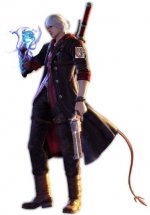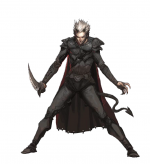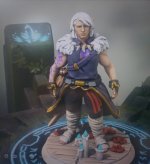Tieflings in my Jewel of the Desert game are somewhat variable, but tend to have the following physical characteristics.
Tail: All tieflings have a tail, unless amputated or otherwise lost. For some it may be shorter/thinner than others, but it's always there. Some can use it precisely enough to develop prehensile skill, but for most it's just there. They design their chairs and pants differently as a result.
Horns: Many, though not all, have a pair of horns, varying in size and shape. Our party Bard has two pretty small horns, which easily get lost in his hair if he lets it grow out a bit. His elder brother has slightly more prominent horns, and IIRC one of his known ancestors (an nth-great aunt who was canonized) had a much more prominent pair.
Skin tone/hair color: More variable than base humans, but not dramatically so. Essentially, red and blue get added to the possible tones human skin can have (as opposed to the natural shades-of-orange color of human skin.) Hair mostly follows suit.
Limbs: Most tieflings have plantigrade feet and do not have claws or other unusual hands, but a few (particularly if they have more of a "throwback" look) may manifest either of these traits. Extra limbs are not a tiefling trait; they might come from somewhere else, but not because of being a tiefling.
Eyes: Tend toward yellow/gold, red, purple, or white/silver, but might have human colors instead. Some of them have heterochromia.
There's no special hatred for tieflings because my setting is low on "racism" in the usual sense and more (relatively mild) xenophobia. That is, someone native to the Tarrakhuna region would be traditionally understood to be "one of us," while someone from outside the Tarrakhuna would be seen as a suspicious outsider. These attitudes have grown much weaker as international trade has grown, but it's still there somewhat. A native Tarrakhuna tiefling would be treated to essentially zero crap, but a human or elf from Yanxia (the faraway East Asia melange) might deal with some discriminatory treatment, especially the lower class (who are the most likely to see foreigners as either rich jerks or immigrants TERKIN AR JERBS!!) But by and large even that is relatively uncommon, the Tarrakhuna has something of a "pan-mortal" perspective due to mortal solidarity being one of the main reasons the enslaving Genie-Rajahs were driven out of the mortal world.
Basically, our Bard could possibly pass for human if seen exclusively from the front (or keeping his tail well-hidden), but his elder brother couldn't except perhaps at a distance, and some of his relatives in ages past definitely couldn't even at a distance.





